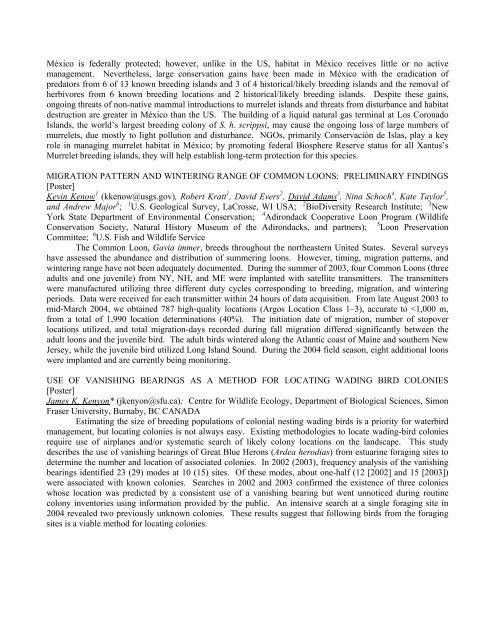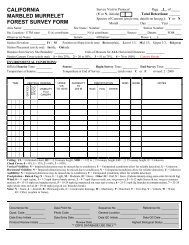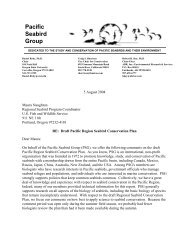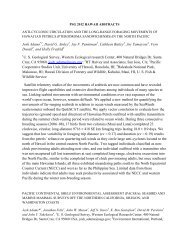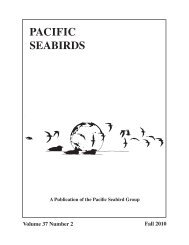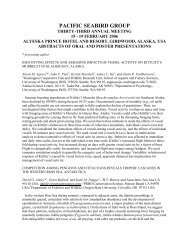abstracts of oral and poster presentations - Pacific Seabird Group
abstracts of oral and poster presentations - Pacific Seabird Group
abstracts of oral and poster presentations - Pacific Seabird Group
You also want an ePaper? Increase the reach of your titles
YUMPU automatically turns print PDFs into web optimized ePapers that Google loves.
México is federally protected; however, unlike in the US, habitat in México receives little or no active<br />
management. Nevertheless, large conservation gains have been made in México with the eradication <strong>of</strong><br />
predators from 6 <strong>of</strong> 13 known breeding isl<strong>and</strong>s <strong>and</strong> 3 <strong>of</strong> 4 historical/likely breeding isl<strong>and</strong>s <strong>and</strong> the removal <strong>of</strong><br />
herbivores from 6 known breeding locations <strong>and</strong> 2 historical/likely breeding isl<strong>and</strong>s. Despite these gains,<br />
ongoing threats <strong>of</strong> non-native mammal introductions to murrelet isl<strong>and</strong>s <strong>and</strong> threats from disturbance <strong>and</strong> habitat<br />
destruction are greater in México than the US. The building <strong>of</strong> a liquid natural gas terminal at Los Coronado<br />
Isl<strong>and</strong>s, the world’s largest breeding colony <strong>of</strong> S. h. scrippsi, may cause the ongoing loss <strong>of</strong> large numbers <strong>of</strong><br />
murrelets, due mostly to light pollution <strong>and</strong> disturbance. NGOs, primarily Conservación de Islas, play a key<br />
role in managing murrelet habitat in México; by promoting federal Biosphere Reserve status for all Xantus’s<br />
Murrelet breeding isl<strong>and</strong>s, they will help establish long-term protection for this species.<br />
MIGRATION PATTERN AND WINTERING RANGE OF COMMON LOONS: PRELIMINARY FINDINGS<br />
[Poster]<br />
Kevin Kenow 1 (kkenow@usgs.gov), Robert Kratt 1 , David Evers 2 , David Adams 3 , Nina Schoch 4 , Kate Taylor 5 ,<br />
<strong>and</strong> Andrew Major 6 ; 1 U.S. Geological Survey, LaCrosse, WI USA; 2 BioDiversity Research Institute; 3 New<br />
York State Department <strong>of</strong> Environmental Conservation; 4 Adirondack Cooperative Loon Program (Wildlife<br />
Conservation Society, Natural History Museum <strong>of</strong> the Adirondacks, <strong>and</strong> partners); 5 Loon Preservation<br />
Committee; 6 U.S. Fish <strong>and</strong> Wildlife Service<br />
The Common Loon, Gavia immer, breeds throughout the northeastern United States. Several surveys<br />
have assessed the abundance <strong>and</strong> distribution <strong>of</strong> summering loons. However, timing, migration patterns, <strong>and</strong><br />
wintering range have not been adequately documented. During the summer <strong>of</strong> 2003, four Common Loons (three<br />
adults <strong>and</strong> one juvenile) from NY, NH, <strong>and</strong> ME were implanted with satellite transmitters. The transmitters<br />
were manufactured utilizing three different duty cycles corresponding to breeding, migration, <strong>and</strong> wintering<br />
periods. Data were received for each transmitter within 24 hours <strong>of</strong> data acquisition. From late August 2003 to<br />
mid-March 2004, we obtained 787 high-quality locations (Argos Location Class 1–3), accurate to


